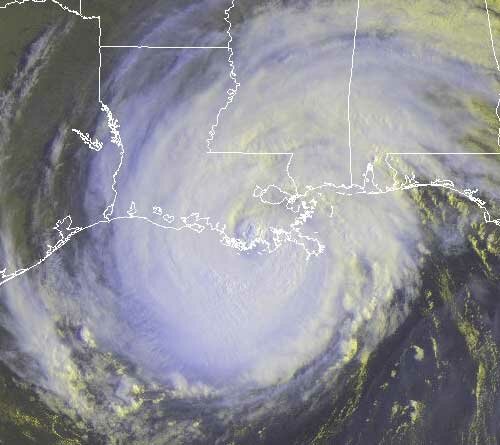Hurricane Gustav made landfall about 10 AM in Cocodrie, Louisiana, about 70 miles southwest of New Orleans. At this point, it looks like New Orleans will not face a repeat of the disaster brought about by Hurricane Katrina, although I suspect that we’ll know more in the morning. Here’s a satellite picture of Gustav taken about 9:45, just before landfall:

Gustav is expected to linger in the Arkansas/Texas/Oklahoma area for a few days dropping plenty of rain, possibly up to 20 inches in some areas. At some point, it’s going to get picked up by a low pressure system and taken northwest into Ohio. This means that except for the few showers Georgia is seeing today from extended hurricane bands, we aren’t likely to have any effects from Gustav.
Don’t worry though, because there is more where that came from. Hanna was upgraded to a hurricane this morning, about a day faster than what was previously forecast by the Tropical Prediction Center. The latest estimate is that Hanna will not change position much through Tuesday before becoming a category 2 hurricane early Thursday and beginning a northward trek that could lead to landfall in Georgia. The current estimate puts landfall near Savannah sometime on Friday, followed by a rapid move north into the Mid-Atlantic.
There is still some uncertainty over exactly where Hanna will make landfall and the exact strength of the storm when it does, but no matter whether it’s Brunswick, Savannah or Charleston, I wonder if the networks will pay as much attention to Hanna as they are to Gustav. In any case, as I heard Joe Bastardi say on the radio this afternoon, Atlanta and Macon are likely to get only a “glancing blow” from Hanna. Bastardi pointed to Hurricane Floyd back in 1999 as his guess of a comparable storm.
If Gustav and Hanna aren’t going to be drought-busters in Georgia, maybe the third time will be the charm. The Hurricane Center today identified Tropical Depression Eight, which by afternoon became Tropical Storm Ike. Ike has been brewing as a low pressure system off the coast of Africa for the past few days, and will move across the Atlantic fairly rapidly, probably turning into a hurricane by Wednesday. By Saturday, it will be in roughly the same location that Hanna is today.
While it’s too early to tell exactly what will happen to Ike once he approaches the Bahamas. It could follow Hanna north along the east coast, or move into the Gulf coast either through or south of Florida. The European model has Ike moving into the eastern Gulf and then recurving north through Alabama and Georgia sometime after September 10th.
And don’t look now, but there’s another strong tropical wave southeast of the Cape Verde Islands that the hurricane center says could develop into yet another tropical depression or storm in the next day or two. If it does, it will be named Josephine.
Sphere: Related Content


